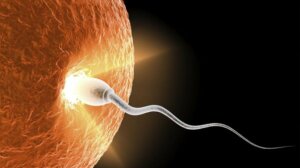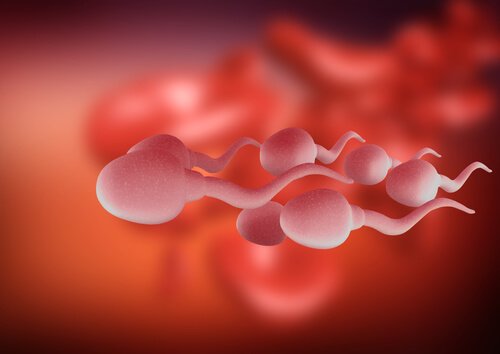How a Baby is Conceived

Conception is, without a doubt, a beautiful phenomenon. However, you may not know what happens inside the body when a baby is conceived and how those processes correspond to thousands of years of evolution. And, the end result, is almost perfect.
If you’re curious about this process, this article is for you. Today, we’ll talk about the physical and hormonal changes that result in the creation of sex cells. These are the vital structures that guarantee fertilization. Keep reading to learn more!
What happens inside the father when a baby is conceived

For fertilization to occur, a man’s body has to develop specialized sex cells called sperm. This process takes place in the testicles, the male sex organs that also play an important role. Their role is to release hormones such as testosterone.
This process, also known as spermatogenesis, can take a little over two months in healthy men. That’s because these cells are very specialized and complex, from their structure to their inner workings.
You should note that the content of sperm isn’t made up entirely of sperm. After your body produces these cells and releases them along the sperm pathways, they combine with seminal fluid. Then, that fluid provides fluidity to the sperm, as well as nutrients so that the cells can survive for several hours or days.
Does that sperm pathways term sound familiar to you? They’re the set of structures that transport spermatozoa from the production site to the outside. Generally speaking, these structures include the epididymis, the vas deferens, and the urethra. This last organ is also part of a women’s body and this is where urine passes.
The epididymis requires special mention. In this structure, the sperm are able to mature thanks to the release of specific proteins. In addition, it serves as a storage place for these cells until the man ejaculates. The sperm will stay dormant here until it’s time to act.
Discover: What Do Men Experience During Pregnancy?
What happens inside the mother?
The body of a developed woman is ready to conceive a baby. This is proven by the woman’s regular menstruations each month, which actually correspond to the preparation and failure of fertilization. When we say “failure,” we mean that menstrual bleeding is the result of the endometrium wall shedding when conception doesn’t occur.
For this process to occur, a woman’s body must also produce sex cells. These are ovules and are one the most interesting structures in the entire body. Unlike men, these structures originate and develop in the female before they’re even born.
Therefore, from the first day of the baby’s life, they already have several ovules (in immature forms) within the ovaries. Ovaries are the female sex organs and they’re equivalent to testicles in men. As the years pass, and a woman’s hormones start to take effect, the vast majority of eggs die or degenerate.
Ovulation is the process of an ovary releasing an egg. This occurs once during each menstrual cycle and, in most women, the egg is released each month from a different side. That’s because, each month, ovulation will take place in a different ovary in order to ensure reproduction if one ovary is dysfunctional.
Finally, the ovum travels through the uterine tubes until it meets a sperm and the process of conception begins. If conception doesn’t happen, all the physical and hormonal changes associated with menstruation will occur.
Keep reading: Expecting Mothers: Physiological Changes
How is a baby conceived?

The awaited moment has arrived: making a baby. Although there are still some doubts regarding this process, we understand the general aspects very well. Once partners have had sex, the sperm has a very limited life (usually a few hours or days) to find an egg.
The sperm’s structure facilitates this process since they have a tail, known as a flagellum. This structure allows them to travel at high speeds. Once the long-awaited encounter takes place, some very rapid molecular changes will take place within the ovum that prevent other sperm from penetrating it.
However, some controversy still exists as to what actually happens in those moments. If there are several sperm that reach the egg’s surface at the same time, it’s likely that a “selection” process takes place. The goal of this process is to find the sperm with the best genetic characteristics.
Then, once both cells meet and combine the genetic material of the mother and father, an intense process of cell production will begin. This results in implantation in the walls of the endometrium and the development of what in the future will become a baby.
A complex and beautiful process
Of course, we left some parts of the process out. However, in general, the concept of how a baby is conceived makes a lot of sense. It’s definitely a beautiful process that demonstrates the immense effort that it takes to bring a new member of the family into this world.
Conception is, without a doubt, a beautiful phenomenon. However, you may not know what happens inside the body when a baby is conceived and how those processes correspond to thousands of years of evolution. And, the end result, is almost perfect.
If you’re curious about this process, this article is for you. Today, we’ll talk about the physical and hormonal changes that result in the creation of sex cells. These are the vital structures that guarantee fertilization. Keep reading to learn more!
What happens inside the father when a baby is conceived

For fertilization to occur, a man’s body has to develop specialized sex cells called sperm. This process takes place in the testicles, the male sex organs that also play an important role. Their role is to release hormones such as testosterone.
This process, also known as spermatogenesis, can take a little over two months in healthy men. That’s because these cells are very specialized and complex, from their structure to their inner workings.
You should note that the content of sperm isn’t made up entirely of sperm. After your body produces these cells and releases them along the sperm pathways, they combine with seminal fluid. Then, that fluid provides fluidity to the sperm, as well as nutrients so that the cells can survive for several hours or days.
Does that sperm pathways term sound familiar to you? They’re the set of structures that transport spermatozoa from the production site to the outside. Generally speaking, these structures include the epididymis, the vas deferens, and the urethra. This last organ is also part of a women’s body and this is where urine passes.
The epididymis requires special mention. In this structure, the sperm are able to mature thanks to the release of specific proteins. In addition, it serves as a storage place for these cells until the man ejaculates. The sperm will stay dormant here until it’s time to act.
Discover: What Do Men Experience During Pregnancy?
What happens inside the mother?
The body of a developed woman is ready to conceive a baby. This is proven by the woman’s regular menstruations each month, which actually correspond to the preparation and failure of fertilization. When we say “failure,” we mean that menstrual bleeding is the result of the endometrium wall shedding when conception doesn’t occur.
For this process to occur, a woman’s body must also produce sex cells. These are ovules and are one the most interesting structures in the entire body. Unlike men, these structures originate and develop in the female before they’re even born.
Therefore, from the first day of the baby’s life, they already have several ovules (in immature forms) within the ovaries. Ovaries are the female sex organs and they’re equivalent to testicles in men. As the years pass, and a woman’s hormones start to take effect, the vast majority of eggs die or degenerate.
Ovulation is the process of an ovary releasing an egg. This occurs once during each menstrual cycle and, in most women, the egg is released each month from a different side. That’s because, each month, ovulation will take place in a different ovary in order to ensure reproduction if one ovary is dysfunctional.
Finally, the ovum travels through the uterine tubes until it meets a sperm and the process of conception begins. If conception doesn’t happen, all the physical and hormonal changes associated with menstruation will occur.
Keep reading: Expecting Mothers: Physiological Changes
How is a baby conceived?

The awaited moment has arrived: making a baby. Although there are still some doubts regarding this process, we understand the general aspects very well. Once partners have had sex, the sperm has a very limited life (usually a few hours or days) to find an egg.
The sperm’s structure facilitates this process since they have a tail, known as a flagellum. This structure allows them to travel at high speeds. Once the long-awaited encounter takes place, some very rapid molecular changes will take place within the ovum that prevent other sperm from penetrating it.
However, some controversy still exists as to what actually happens in those moments. If there are several sperm that reach the egg’s surface at the same time, it’s likely that a “selection” process takes place. The goal of this process is to find the sperm with the best genetic characteristics.
Then, once both cells meet and combine the genetic material of the mother and father, an intense process of cell production will begin. This results in implantation in the walls of the endometrium and the development of what in the future will become a baby.
A complex and beautiful process
Of course, we left some parts of the process out. However, in general, the concept of how a baby is conceived makes a lot of sense. It’s definitely a beautiful process that demonstrates the immense effort that it takes to bring a new member of the family into this world.
All cited sources were thoroughly reviewed by our team to ensure their quality, reliability, currency, and validity. The bibliography of this article was considered reliable and of academic or scientific accuracy.
- Álvarez-Díaz J, et al. Mecanismo de la fecundación humana. Revista Peruana de Ginecología y Obstetricia 2007;53(1).
This text is provided for informational purposes only and does not replace consultation with a professional. If in doubt, consult your specialist.








